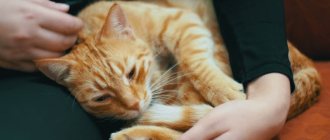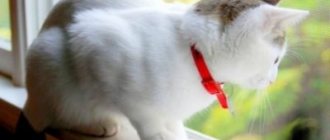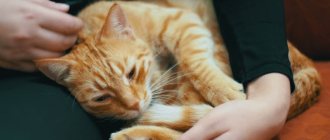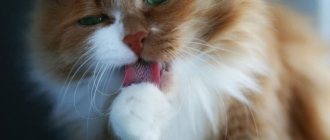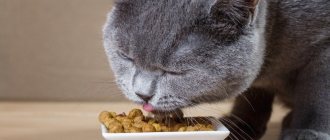9162Administration
Oxytocin is a hormonal drug that affects uterine contraction, myoepithelial cells and mammary ducts. In a cat's body, this is a hormone from the posterior lobe of the pituitary gland, which is produced during contractions and when the nipples are irritated. Oxytocin is used during childbirth in cats to quickly expel the kitten's fetus and further reduce it.
The composition of Oxytocin acts quickly: the substance dissolves in the blood in no more than 6 minutes, and the body’s first reaction is observed within 3-4 minutes.
© shutterstock
Composition and release form
Oxytocin is a drug that is a colorless solution, without mechanical inclusions and with a weak specific odor, packaged in glass ampoules or bottles of various volumes: 10, 20, 100 ml. Containers can be transparent or dark. The bottles are hermetically sealed with rubber stoppers and special aluminum caps, and the ampoules are sealed under sterile conditions.
1 ml of solution contains:
- 5 units or 10 units of oxytocin;
- stabilizer;
- preservative;
- pyrogen-free water.
Important! Before using any medicine, prior consultation with a veterinarian is required.
Normal and abnormal course of labor
Prevention of all possible complications during childbirth begins with caring for a pregnant cat . As soon as you discover that your pet is pregnant, regardless of whether mating was planned, she must be shown to a veterinarian.
A cat's pregnancy can be determined from 2–3 weeks using a blood test. At 3–4 weeks, the expectant mother's mammary glands swell. As the gestation period increases, the following signs are observed:
- Increased hunger.
- Redness of the nipples.
- Toxicosis.
- Slight but constant weight gain.
- Behavioral changes - frequent meowing, restlessness, unusual affection or irritability.
During the normal course of pregnancy, by about 5–6 weeks, the pet’s belly becomes noticeably rounded. If gestation proceeds without complications, the cat receives decent care, has no genetic defects, and birth occurs from 64 to 71 days of pregnancy.
Important! During the normal course of pregnancy, before the onset of contractions, the cat should not experience any discharge from the genitals. The only exception is early rejection of the mucus plug, which can occur several weeks before birth.
It will be easier for an inexperienced owner to cope with the situation if the nest for birth is prepared in advance. It is necessary to monitor the cat’s behavior; most often, she herself chooses a suitable (from her point of view) place. You can take the initiative and equip a nest for your cat from a spacious box. In order for the expectant mother to feel safe, the box must be closed (have a roof).
During the first contractions, you may find that the cat is restless, constantly entering the nest, or looking for a suitable place to give birth to kittens. The pet can meow loudly and attract the attention of the owner, especially if she is about to give birth for the first time. The first contractions bring discomfort, but the cat successfully hides the pain. The owner may not notice the discharge of amniotic fluid and the rejection of the mucous plug, since the cat licks the genital area.
As the labor process progresses, contractions will intensify and the interval between them will decrease. When the interval is reduced to 20–30 seconds, the cat will lie down on its side and prepare to push.
The first kitten takes longer to be born than all the others; to expel it, the cat will need to make 3-4 strong attempts. The total duration of the process from the start of contractions to the appearance of the first kitten can take from 2 to 24 hours. Normally, contractions last up to 12 hours, and pushing at the birth of the first kitten lasts up to 1 hour.
Note! After the birth of the first kitten, the remaining babies should appear at intervals of 10–20 minutes.
As soon as the baby is born, the cat licks its face, gnaws the umbilical cord and eats the afterbirth. If the woman in labor does not pay attention to the kitten, and the expulsion occurs too quickly, the pet may be in rapid labor. This complication is associated with severe pain, so it is advisable to immediately remove the kittens from the nest, remove fluid from the respiratory tract, rub them and place them on a heating pad.
Directions for use and dosage
This drug is administered to animals using various methods: under the skin, into muscles, into a vein, and less often epidurally.
Oxytocin is used in dogs, cats, goats, sheep, cows, sows and mares in varying dosages. When the drug is administered subcutaneously or intramuscularly, the desired result comes in one to three minutes, and the effect lasts for up to 30 minutes. When administered intravenously, the drug begins to act within 30-60 seconds.
Did you know? Australian scientists have found that injections of oxytocin in large doses make animals immune to alcohol.
For dogs
To know how much oxytocin a dog needs to inject during childbirth, you should take into account the method of administering the drug. For subcutaneous and intramuscular administration, 5-10 units are required, and for intravenous administration - 2-7 units.
Find out how to detect and treat a dog for demodicosis, piroplasmosis, dirofilariasis, elbow bursitis, and lichen.
The drug should be injected only after the birth of the first puppy; first you need to do a fluoroscopy, ultrasound examination and monitor the dog’s heart rate. Do not ignore these recommendations, since an incorrectly positioned fetus can cause rupture of the animal’s uterus and even its death. Don't take responsibility, contact a specialist.
For cats
The dose of oxytocin depends on how it is injected into the cat: subcutaneous and intramuscular administration - 3 units, intravenous - 2 units, epidural - 2 units. All medical interventions must be coordinated with a veterinarian. The introduction is not carried out until the birth of the first kitten, especially if the fetus is stuck in the birth canal of the animal. It is necessary to administer the medicine not during a contraction (!), and if there is no effect, then after 20 minutes the injection can be repeated.
Learn all about mating and pregnancy in cats; How does sterilization affect your pet's health?
When not to use oxytocin
Among the contraindications are:
- scars on smooth muscles, which include the uterus. This may cause injury.
- Malposition. The use of Oxytocin is not recommended if the fetus is positioned sideways in the uterus: this can cause fatal injuries to the kitten.
- Tachycardia and bronchospasms. This creates a threat not only for the kitten, but also for the animal, which may not tolerate childbirth and third-party hormonal influences.
- Intolerance. Oxytocin should be injected into a cat after and before birth only in consultation with a veterinarian. Not every pet can tolerate the effects of the drug, which depends on the individual predisposition of the body.
Safety and personal hygiene measures
When using this product, general hygiene and safety precautions must be observed:
- do not leave empty containers of the drug for household use, discard them immediately;
- wash your hands thoroughly after finishing work with oxytocin;
- If the product gets on the skin or mucous surfaces, immediately rinse them with plenty of water;
- If signs of an allergic reaction appear, consult a doctor immediately;
- Do not leave the drug in a place where children can find it.
Oxytocin during cat birth
Oxytocin-based drugs are quite widely used in obstetrics. The names of the medications may vary, but the active ingredient remains the same. Oxytocin is used to stimulate contractions, pushing and lactation after parturition in cats.
Recently, many experienced breeders and veterinarians are refusing to use oxytocin unless absolutely necessary. However, despite all the arguments against, the drug remains the only alternative in case of stopping labor.
Oxytocin is a hormone that must be produced in the cat's body. The production of oxytocin begins from the day of fertilization and increases throughout the entire gestation period. It is Oxytocin that triggers labor when its concentration in the blood becomes critical. Normally, the cat's hypothalamus should produce enough oxytocin to start the birth process and successfully complete it.
This is interesting! Few people know that Oxytocin increases the ability of sodium molecules to penetrate muscle tissue. When the hormone enters the uterine tissue, it contracts strongly and sharply, which helps push the kitten or placenta towards the birth canal.
In some cases, if a cat has lost milk after giving birth, artificial administration of oxytocin helps restore lactation . However, in case of lactation problems, this drug is rarely recommended as there are a number of safer alternatives.
Contraindications and side effects
Oxytocin should not be used for the following conditions:
- the fruit is larger than normal;
- a fetus with deformities and developmental disabilities;
- malpositioned fetus.
No complications or side effects were identified after taking this drug.
Overdose can cause uterine hyperstimulation, vomiting, tachycardia and hypotension. Oxytocin can be combined with other medications. During its use for farm animals, there is no prohibition on human consumption of animal products.
Important! If a quick effect is needed, then oxytocin is administered along with glucose, and its amount is reduced by 30%.
Help after childbirth
- Pets may need help after the babies are born. If they are weakened, a drop of Traumwell is dripped into the kittens' mouths every 15 minutes for 2 hours. You can also give the drug to your cat - this will help relieve pain during the birth process.
- “Oxytocin” is administered to the cat after birth for 3 hours, but experienced breeders do not advise doing this, especially if the birth was accompanied by large blood losses. An inexperienced owner may not realize the pathology, in which case the injection can lead to rupture of the uterine wall.
- If everything is normal, there is confidence that the birth took place without complications, then after 12-24 hours, to contract the uterus and stimulate lactation, repeat the injection of “Oxytocin” at 0.25 ml - it is given intramuscularly, after 30-45 minutes, the total dose is 1 ml .
- Using the same algorithm and with the same precautions, they administer “Oxytocin” to the dog after birth.
- When giving birth to animals, it is preferable to use veterinary drugs to stimulate labor. At the stage of the first attempts, it is better to administer “Travmatin” in combination with “Aminovit”, 1 unit each. Oxytocin should be given 12 hours later within 2 days after birth. Thus, the animal’s body will recover faster and there will be more milk.
Have a successful birth for your pet and healthy kittens!
a piggy bank of tips
THIS IS TIPS. TREATMENT AND RECOMMENDATIONS ARE TO THE Veterinarian. I AM ONLY A BREEDER.
giving birth to a cat, helping a cat during childbirth
A cat's gestation period is 58-72 days. If the cat’s labor is good, then there is no need to use medications before and during birth. After birth, two hours after the last kitten, oxytocin can be administered to better cleanse the uterus and increase milk lactation.
use of medications during cat birth
For experienced breeders this advice is unnecessary, but for beginners I would like to remind you that you are not a veterinarian. Therefore, use medications very carefully and do not try to pour and inject everything into the cat. Improper use of medications can seriously harm your cat.
traumatizing a cat during childbirth
Travmatin® acts on the neuroendocrine system, stimulates the production of endogenous (own) oxytocin, which leads to uterine contractions. In addition, Travmatin® has an analgesic and hemostatic effect. Even during normal childbirth without obstetric care, there is a risk of microtrauma to the mucous membrane of the cervix and vagina. Therefore, Travmatin® should be administered both at the beginning of labor and at the end of the process. This allows you to avoid complications both during childbirth and in the postpartum period, prevents inflammatory diseases of the genital organs and promotes normal involution of the uterus (when the uterus returns to its original state). The composition of Travmatin® in microdoses includes natural components created on the basis of plant raw materials, so it is absolutely harmless to the fetus and the mother in labor.
Contraindications
Oxytocin is strictly contraindicated in case of individual hypersensitivity to the active components of the drug, as well as if there is a threat of uterine rupture due to fetal hypoxia, which is caused by its incorrect location.
In this case, the veterinarian performs a caesarean section.
The medicine is not administered if the natural passage of the fetus through the birth canal is impossible, as well as in case of its deformities, obstetrics in cases of a large fetus.
If there are contraindications to the use of oxytocin or obvious side symptoms are noticeable, stop taking the medication. Animals are prescribed symptomatic therapy.
In case of hypersensitivity to oxytocin, other pharmacological agents may be prescribed to enhance the contractile function of the smooth muscles of the uterus and stimulate labor.
Prevention of prolonged labor
With high-quality care and a normal pregnancy, most cats give birth to offspring without outside help. A young mother is quite capable of setting up a nest for herself, preparing for childbirth on her own, licking all the kittens and pushing them towards the nipples.
As long as the birth occurs without complications, owner intervention is not required, but many women in labor prefer to be observed by a trusted person. Observe the expectant mother; by her behavior you will understand whether she wants your presence during childbirth. If a cat is hiding, try to watch it from the side.
Do not forget that physical activity is very important for the normal development of kittens and preparing the body for childbirth. Try to provoke your cat to play and run. In addition to natural stimulation of the birth process, physical activity during the entire pregnancy will allow the pet to maintain a normal weight.
Important! Obesity in pregnant cats increases the load on the heart, purification and respiratory systems. Significant excess weight often leads to complications during childbirth.
A cat may deliberately delay giving birth if she is unsure of the well-being of the expected offspring. To reduce the stress of the expectant mother, prepare a nest in advance in which the cat will feel cozy and safe. The nest site is usually chosen by the cat.
Before inducing labor at home, be sure to measure your temperature. Before giving birth, the cat's base temperature drops to 37.1–37.2 degrees. If your pet's body temperature has dropped, do not resort to stimulation for two days or until the veterinarian prescribes therapy.
If the gestation period approaches 65 days, and the pet is not preparing for childbirth, red marlin ( common marlin) can be used as a folk remedy to induce labor. The drug is usually sold in gelatin capsules that are easy to open. The contents of one capsule are mixed with canned or natural food once a day.
For stimulation, you can massage the abdomen and nipples . Regardless of whether you use a medicated supplement, try to gently massage your cat's belly and mammary glands. Your manipulations will lead to increased production of oxytocin, the critical concentration of which should trigger contractions.
Monitor closely for behavioral and physiological changes. About 12 hours before the birth of kittens, the expectant mother may experience trembling in the limbs, severe anxiety, deep and rapid breathing, breathing with an open mouth, and active meowing. All these signs indicate that labor is proceeding normally and stimulation is not needed. However, if this condition lasts more than 24 hours, and contractions have not started, you should consult a doctor for advice.
Purpose, indications for use
The action of the drug is aimed at promoting the natural release of the placenta in case of detention. In veterinary medicine, the drug stimulates labor in both agricultural and domestic animals: cattle; sheep; cows; goats
Oxytocin is a fast-acting drug. The effect of its use occurs within 2 minutes when administered intramuscularly or subcutaneously, and when administered intravenously - less than 1 minute.
According to the instructions for use, Oxytocin is used for:
- weak progress of labor;
- endometritis;
- atony and hypotension of the uterus;
- uterine bleeding;
- reflex agalactia;
- mastitis.
